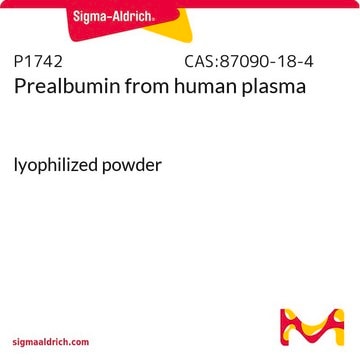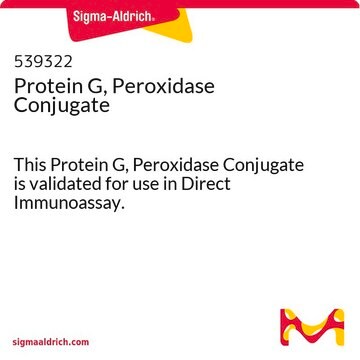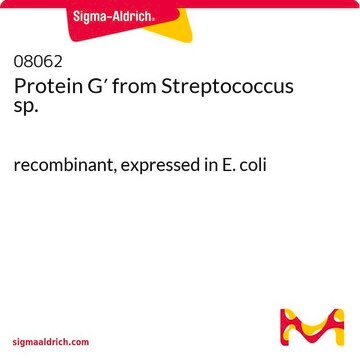529577
Präalbumin, Humanplasma
Synonym(e):
Präalbumin, Humanplasma
Anmeldenzur Ansicht organisationsspezifischer und vertraglich vereinbarter Preise
Alle Fotos(1)
About This Item
Empfohlene Produkte
Assay
>95% (SDS-PAGE)
Qualitätsniveau
Form
lyophilized
Hersteller/Markenname
Calbiochem®
Lagerbedingungen
OK to freeze
Löslichkeit
physiological buffer: soluble
Versandbedingung
ambient
Lagertemp.
−20°C
Allgemeine Beschreibung
Natives Präalbumin aus menschlichem Plasma. Plasmaprotein mit minimalem Kohlenhydratanteil. In einer Menge von rund 300 mg/100 ml in Plasma enthalten. Ist beteiligt am Transport von Retinol-bindendem Protein, Tyroxin und Vitamin A.
Natives Präalbumin aus menschlichem Plasma. Plasmaprotein mit minimalem Kohlenhydratanteil. In einer Menge von rund 30 mg/100 ml in Plasma enthalten. Ist beteiligt am Transport von Retinol-bindendem Protein, Tyroxin und Vitamin A.
Warnhinweis
Toxizität: Standard-Handhabung (A)
Physikalische Form
Lyophilisiert aus 150 mM NaCl, 50 mM Natriumphosphatpuffer, pH-Wert 7,5.
Angaben zur Herstellung
Aus Plasma hergestellt, das in zertifizierten Tests für HBsAg und Antikörper gegen HIV und HCV als negativ befunden wurde.
Rekonstituierung
Das chargenspezifische Rekonstitutionsvolumen entnehmen Sie dem Produktetikett.
Nach der Rekonstitution in Aliquote aufteilen und für die langfristige Lagerung einfrieren (-20 °;C) oder für die kurzfristige Lagerung im Kühlschrank (4 °;C) aufbewahren. Stammlösungen sind bei einer Temperatur von 4 °;C bis zu 2 Wochen und bei einer Temperatur von -20 °;C bis zu 6 Monate stabil.
Sonstige Hinweise
Blaney, J.M., et al. 1982. J. Am. Chem. Soc.104, 6424.
Rechtliche Hinweise
CALBIOCHEM is a registered trademark of Merck KGaA, Darmstadt, Germany
Lagerklassenschlüssel
11 - Combustible Solids
WGK
WGK 1
Flammpunkt (°F)
Not applicable
Flammpunkt (°C)
Not applicable
Analysenzertifikate (COA)
Suchen Sie nach Analysenzertifikate (COA), indem Sie die Lot-/Chargennummer des Produkts eingeben. Lot- und Chargennummern sind auf dem Produktetikett hinter den Wörtern ‘Lot’ oder ‘Batch’ (Lot oder Charge) zu finden.
Besitzen Sie dieses Produkt bereits?
In der Dokumentenbibliothek finden Sie die Dokumentation zu den Produkten, die Sie kürzlich erworben haben.
Lidia Ciccone et al.
Nutrients, 15(3) (2023-02-12)
Eicosapentaenoic acid (EPA; 20:5) and docosahexaenoic acid (DHA; 22:6), two omega-3 poly-unsaturated fatty acids (PUFAs), are the main components in oil derived from fish and other marine organisms. EPA and DHA are commercially available as dietary supplements and are considered
Christopher L Cioffi et al.
Journal of medicinal chemistry, 64(13), 9010-9041 (2021-06-18)
Dissociation of transthyretin (TTR) tetramers may lead to misfolding and aggregation of proamyloidogenic monomers, which underlies TTR amyloidosis (ATTR) pathophysiology. ATTR is a progressive disease resulting from the deposition of toxic fibrils in tissues that predominantly presents clinically as amyloid
Christopher L Cioffi et al.
Journal of medicinal chemistry, 63(19), 11054-11084 (2020-09-04)
Accumulation of cytotoxic lipofuscin bisretinoids may contribute to atrophic age-related macular degeneration (AMD) pathogenesis. Retinal bisretinoid synthesis depends on the influx of serum all-trans-retinol (1) delivered via a tertiary retinol binding protein 4 (RBP4)-transthyretin (TTR)-retinol complex. We previously identified selective
Xiao-Min Ren et al.
Environmental health perspectives, 128(10), 107008-107008 (2020-10-24)
Tetrabromobisphenol A (TBBPA) mono-ether structural analogs, identified as the by-products or transformation products of commercial TBBPA bis-ether derivatives, have been identified as emerging widespread pollutants. However, there is very little information regarding their toxicological effects. We aimed to explore the
Unser Team von Wissenschaftlern verfügt über Erfahrung in allen Forschungsbereichen einschließlich Life Science, Materialwissenschaften, chemischer Synthese, Chromatographie, Analytik und vielen mehr..
Setzen Sie sich mit dem technischen Dienst in Verbindung.







